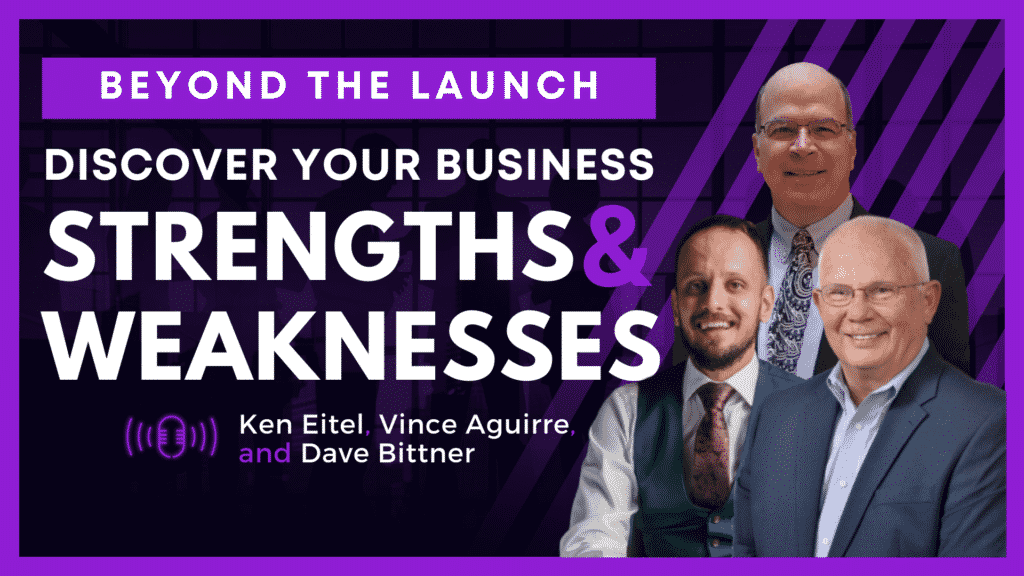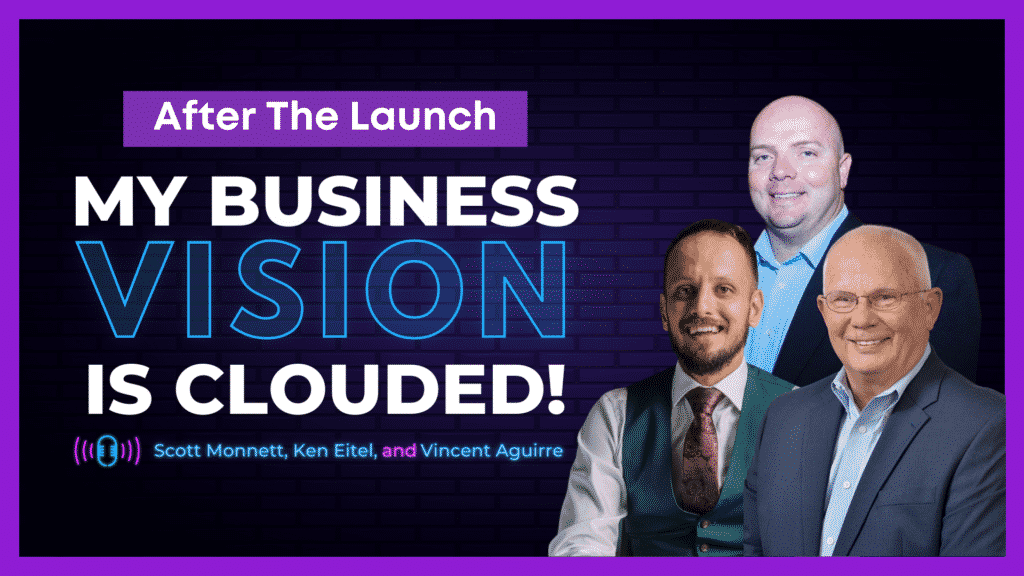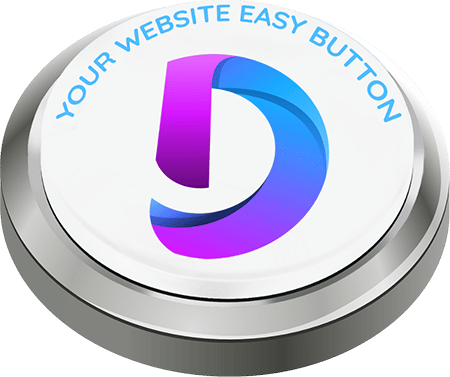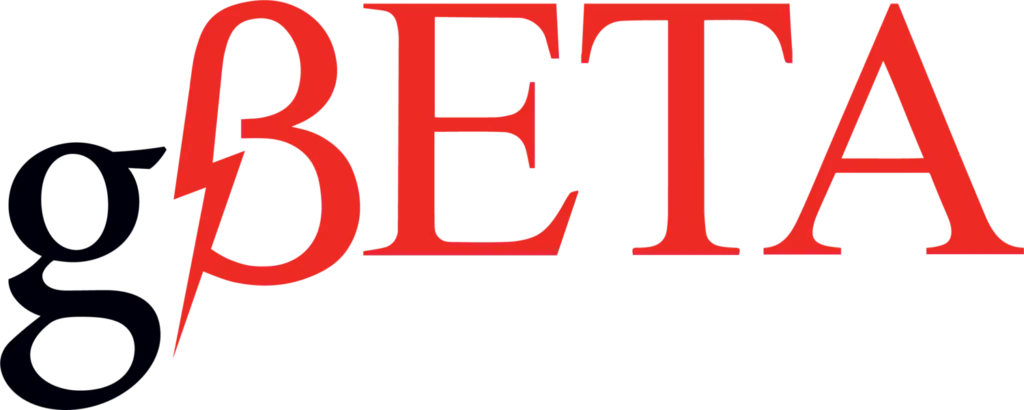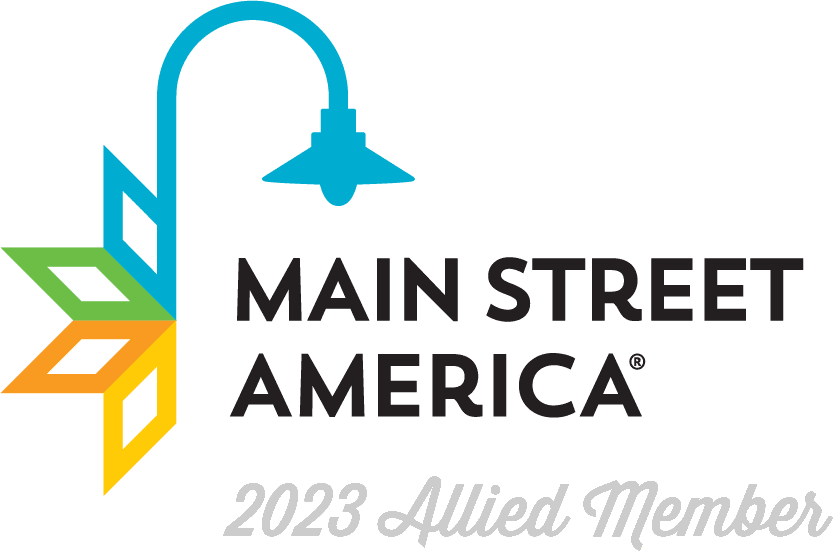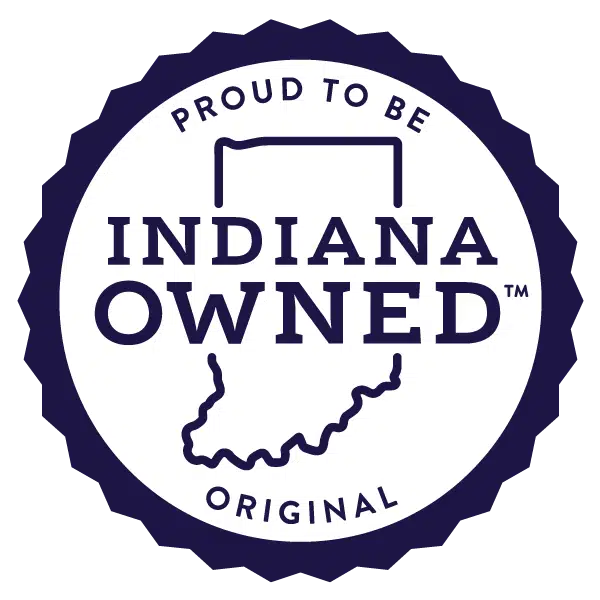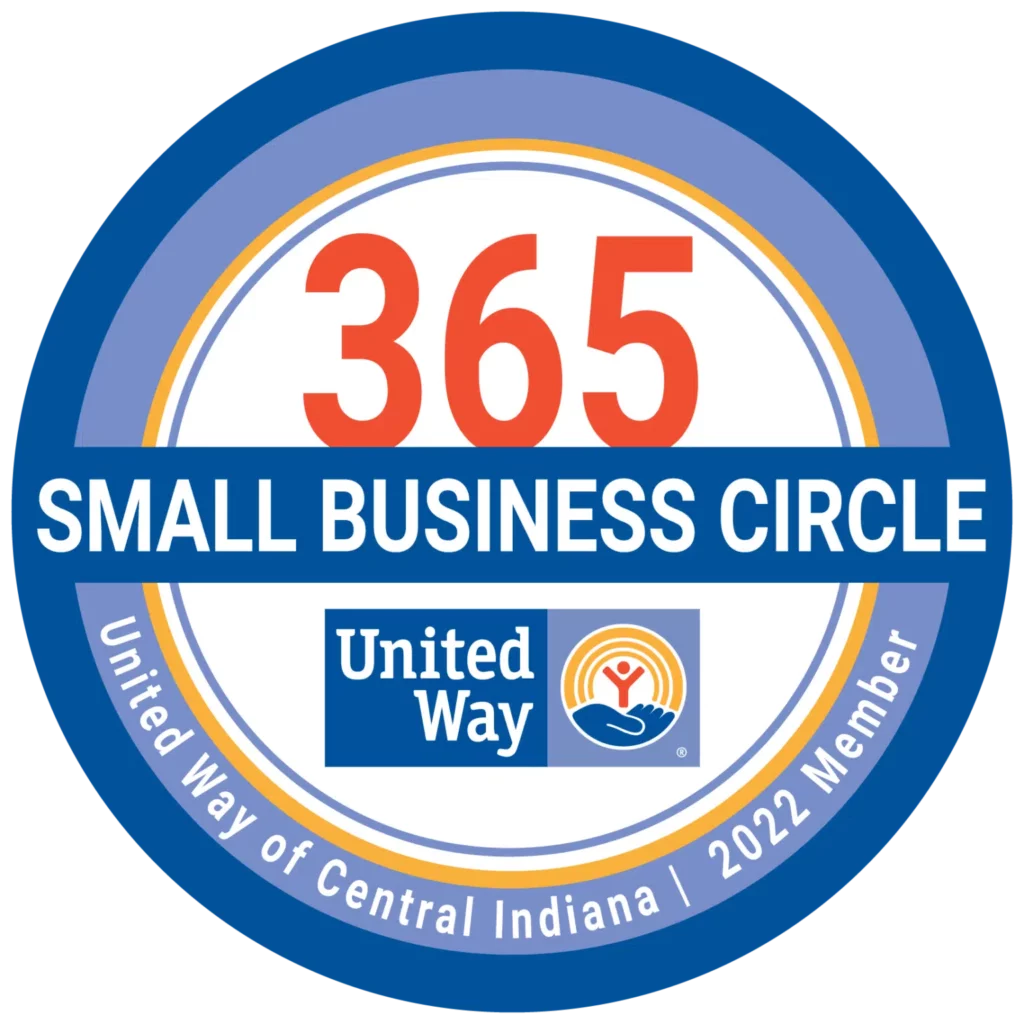Watch The On-Demand Video Or Read The Transcript Below
The customers and community were excited, yet a few months or years in, something has changed. Join Vince, Ken, and guest Dave Bittner of the Indiana Small Business Development Center, for a discussion on utilizing your business' strengths and recognizing its weaknesses to energize and grow your business going forward.
Listen To The Podcast
Check out our other Small Business Squad podcasts HERE!
Transcript
- 2:32 Identifying Business Opportunities
- 6:51 Overnight Success Doesn't Really Happen
- 10:29 Enhance Your Relationship With Your Customers
- 13:37 Businesses Threats
- 17:25 You Can Do Something About Every Threat
- 20:58 Organized Abandonment
- 23:47 Looking For Your Business Sweet Spot
- 27:27 Spend Your Time Wisely
- 28:38 How Fast Things Increased with Technology
- 33:13 Methods in Identifying Opportunities & Threats
- 35:28 Visualizing the SWOT Diagram
- 39:28 How Helpful is the SWOT Diagram for your Business
Vincent Aguirre: Hello, everyone, my name is Vince Aguirre. I'm the president of Distinct and the host of the Small Business Squad podcast. Today, I have some familiar faces with me, Ken Eitel and Dave Bittner, both join him to continue our conversation. last week that we started, we started talking about your strengths and weaknesses in your business. Today we're talking about Opportunities and Threats to complete the SWOT analysis. Ken, Dave, how are you guys doing today?
Ken Eitel: We're doing great, Vince.
Dave Bittner: Very well.
Vince: Good. Good. I know I'm having some technical difficulties on my end, but you guys seem to be doing all right. So hopefully, you'll carry the show today.
Ken: We can. We can lead you along.
Vince: You always do Ken. I guess Ken, why don't you take over? Why don't you lead the show and kind of catch us up on where we were last week and where we're heading today.
Ken: Okay, so we're gonna talk a little bit again, about the SWOT diagram, which is the acronym S-W-O-T, which is for strengths, weaknesses, opportunities, and threats. Dave is with the ISPDC and West Central Indiana, which is a state organization, actually, a federal organization that is countrywide, that does free consulting for people wanting to start a business who are in business might be experiencing challenges or expansion. I'm a retired businessman. For some time, I've been a teacher at Ivy Tech in the business department, as well as a director of an entrepreneurship center involved in a number of roles with nonprofits within the community. So, the strengths and weaknesses that we talked about last week, and those sessions are available online, on the YouTube account, so if you want to review those or anything else we've done previously, you can do that. But strengths and weaknesses, for the most part, are external, or internal issues that are what are your strengths, and what are your weaknesses, not just you personally, but also in your, in your business. But today, we're going to talk about opportunities and threats. And those are external. Those are things that are from the outside that you might or might not be able to control within your business itself. And as we get towards the end of our session, Dave's going to show us how these things go together in a diagram, so that you can kind of look at them and what you can do to help build your awareness and help with your strategic plan. So kind of maybe bring these two sessions altogether and show you the benefits of that.
02:32 Identifying Business Opportunities
Ken: So, the opportunity is defined as a situation in which it is possible for you to do something that you want to do. Now, some people can call opportunities, chance, or luck, or is preparation. And there are a number of things that can be opportunities for either a business or a service business or a technology business. Things like your strengths and weaknesses, your strengths especially can be opportunities for you. Your networking, the fact that you're very involved in the community, you're involved with a number of nonprofit organizations, you might be in a leadership role, their competitors, what are your competitors not doing that you couldn't do? What are their strengths? What are your competitors, weaknesses, and new markets? What do you see through your analysis or your discussions within the community? Looking at your competitors, or your peers who may not be in your community? What are some opportunities to maybe add to your core business? To expand somewhat to add to revenue? expanded markets? Are you the kind of individual that can open another location? Will another location add to your business or just take away from your time or take away from you know, what the finances or the resources that you have? I for one have realized that I was not an individual that could have multiple locations. Just my strength as well as one of my weaknesses was that I just needed to be around. And so that's how you can look at some of these things. New products, you know, it's oftentimes that in our case, we'd go to the Gift Show, and we'd find a product, we thought it was just great. And it didn't sell, or we find something that everybody else said we should buy, and we'd buy it and it didn't sell. And so how do you find an opportunity in expanding your product lines and your service lines? In Vince's case, what kind of services do you add to your website business that can bring you additional revenue? So, Vince, what do you see from an opportunity standpoint? The stock is it a chance is it luck? What is opportunity?
Vince: I think it's all of those things. Especially when you're looking at it from a SWOT analysis. It is outlining where you can go, and what opportunities obviously there are out there. But keeping them in mind prepares you for that chance or the luck of where your business might land, right. I think anyone who runs a small business who has been involved in small business understands that you have to be prepared for that opportunity. And for that luck when it comes your way. So, I think it's all the things you outlined. And I think it's important to keep in mind where your opportunities are. So, you know how to head towards them effectively.
Dave: Yeah, this is a great question. Because a lot of us do negative self-talk. And we sometimes think that there are no opportunities, I've started this business, I have a wonderful customer base. As I look around, I my vision is too narrow. And I don't see an opportunity. And it's always there, you can never assume that there's no way to get better that there's a way to improve your product, another customer to go chase. And if you just stop with why I just don't see any opportunities without like we talked about last time networking with people and understanding what's out there. I think that's a, that's a real fault. So just the notion that the opportunities do exist and making the effort to go after them and understand where they are, I think is a great first step other than just thinking otherwise.
06:51 Overnight Success Doesn't Really Happen
Ken: I think that we can talk about opportunities in some of the things that we've talked about previously, sometimes you pointed out that you have to or Vince, you have to prepare for opportunities when they come along the border that goes back to what we talked about when we talked about finances. So, if you're running your business on every sale or every day's deposits, and you have no savings, or you have no way in which to fund a new opportunity, all of a sudden, you can't take advantage of that. By the same token, if you need to hire help, and you just are looking for that one way, you're not going to find some of the opportunities possibly, if you have those blinders on that you talk about, you may find an opportunity with an individual that will come to work for you and fit really well where you didn't think they fit. And so, it's very important, I think, to be able to recognize opportunity without those blinders on. One of the statements that I've heard that I like a lot is that luck is an opportunity prepared for. And so, if you think about that, you say that well so and so's lucky to have this in their business or so and so's lucky to be, “successful” however you measure that. What did they do to prepare for that? What was the preparation there that when that opportunity came along, they were ready. It looks like people on the outside, it's luck. But it's far from luck or chance. It was very much part of our strategic plan for that opportunity.
Vince: Ken, not to take us too far down the rabbit hole. But that reminds me of the saying I heard a few years back. And that whenever you see someone who's an “overnight success”, typically they've been doing that for at least five years without the recognition. And I forget where I saw this, it might have just been in a book or social media posts. But it was saying that all that work behind the scenes was first five years, maybe even 10 years. No one thinks like, “Oh, they're an overnight success.” And then all of a sudden, it's like, “Wow, where did they come from?” And oftentimes is that you've been there the whole time, you just weren't paying attention. And now they've reached this threshold. The opportunity, if you will, has become a success. So, sorry to kind of take us down that path. But you made me think of that.
Ken: Well, I think one of the other things that I always have enjoyed doing is to take a look at people that will say are successful, or you talked about being an overnight success. And look at what I call their backstories. Yeah. And so often, that five years they may have been dabbling in this or learning the business. But before that, there might have been a failure. Or there might have been a situation where they struggled or whatever. That puts them in a position to be able to again, take the opportunity to move ahead, and also be able to be the kind of leader and manager because of experience. And, you know, we all have been around all three of us people who started a business. Oh, yeah, but I've never been in this business. But I think it's a great idea. And experiences are pretty hard to replicate if you don't understand, what the business is. We're gonna move on to Threats. But Dave, anything else to close us out on an opportunity?
10:29 Enhance Your Relationship with Your Customers
Dave: I think one of the things that we can't lose sight of when you think about opportunities is just taking a customer base. And just an analogy here to a past experience I had, we were so focused, “We need more customers, we need more customers.” And we did all these marketing schemes and drove the heck out of the salespeople to build and get more customers. And then we had a salesperson that said, “Well hang on a second. I'm a top sales professional. And I have half the customers as everybody else because I'm maximizing the wallet share of the customers.” And so creatively that salesperson had great relationships with those customers, and they were willing to buy more. And so an opportunity isn't always to grow your business through more people, more locations, more customers more events, it could be you have great relationships with customers, you have now given them more of the things they want, and reach out to them and talk to them about that. So, just a lesson learned from me in the past is that it's not always about breaking your neck trying to knock doors down and get someone to buy a single item from you. But really enhance that relationship and opportunistically help them purchase more from you.
Ken: So, I think about what I call the personal selling circle. And this is something that I taught, but it's it really comes down to taking care of your customers that you have, and continuing to meet their needs. And, and continuing to follow up with them and come right back around to another sale. And so it's a circle, its continuing improvement is continuing attention to the customers you have. Because I can tell you, it's a lot harder to find a new customer than it is to take care of the customers that you have. And I think sometimes we get lost in numbers and dollar figures. And we really forget to take care of that 20% of people that are loyal customers who continue to do business.
Ken: When I was in business, I made sure. And of course, we were in a fresh flower business. So, we needed things that day or the next day. But I made sure that I had a majority supplier so that when I needed something really, really was important, they would bend over backward to take care of me. But that person I might buy from once or twice a month isn't going to be quite as inclined to take care of me in emergency situations. And that just goes all the way through one of my advice has been to my sons is to get a heating and air conditioning person that you like, for example, and always use them. Because when the air conditioner goes out in the middle of the summer, and it's 90 degrees, they're going to take care of you before they take care of a call you've not had before. So those are opportunities they really are I appreciate you bringing that up Dave because I think you're right.
13:37 Businesses Threats
Ken: But by the same token, not taking care of people can be a threat. And we're going to segue into that a little bit and talk about threats. So, threats are, it may include anything that can negatively affect your business from the outside. And you may lack the influence to alter the situation. So, there are some key words in that. For me, one of those is that affects your business negatively from the outside. And that you may not have any control over now, many times these might be macro things. They might be things that are not micro within your community. Or the example I'll give you is the culture-changing impact the internet had on the fresh flower business. I mean that how we used to do that when I first came back to the store with telephone calls to florists and other towns and giving them the order by phone. That changed dramatically with the internet and email and that was a threat. And it still is a threat today to not just florists now but to many many small businesses that we really micro-businesses, small business has no control over you have to learn how to use it and make it an advantage for you. So, some of the other things, that we talked about that word influence. And so, influence control, weakness or awareness, if you're not aware of the development of something like the internet, or in our case, it first really started with 800 numbers and credit cards. And because then you could order directly and bypass the local business. And that, of course, is just increased as well. So, I have down some things that you might think of as our threats. Today, of course, it's cost inventory. We have inflation like we've not seen in decades. And you know, we really don't have a lot of control over that when we come to be in a business or service area. Increasing raw materials or shortage of raw materials, pipeline, whatever that might be the logistics. Another one that's here today that there's not much control over is the labor shortage. We have been watching a person who owns a restaurant locally trying to hire people, and just saw them yesterday and said, “So have you been able to find anybody to hire?” No, they haven't. And this has been going on for some time. And so, those things become real threats to your business and how you're going to adapt to that. Again, a new competitor. You have somebody that opens up, you know, it locally, Invensys Keisha, somebody that gets into the website market, and becomes very aggressive, let's say, in Putnam County or in what use your traditional market. The other ones that are hard to have control over are demographic and cultural shifts. In Greencastle, IBM. In the case of traffic downtown, and the way the DePauw students got downtown when they made a shift and where the housing was the downtown corridor to downtown shifted one block over. And so, these things along with new technology can be real threats that you as a business person need to, you need to be really realistic about this, and find out kind of where things are going and maybe think a little longer term. Dave, how hard is it for people to think out four or five years and see these threats.
17:25 You Can Do Something About Every Threat
Dave: Extremely difficult. I mean, especially in today's environment where things happen at the speed of light, it's just amazing how you think that far out. Actually when I think of threats and trying to plan for them and the unforeseen things that is obviously completely out of your control. You know, Ken, it comes down to as a small business owner, or any leader in an organization. Too obvious to say, but this is where leadership comes out. This is where you have to kind of calmly, analytically, but just with vigor, go after fixing it, and either molding your business or getting your staff back, “Hey, we can do this.” Some positive support for them, give them a plan of attack. But the notion that all threats cannot be solved is folly, that's not true. You can do something about every threat, just some of the threats. And the choices aren't all that great. But you can do something, the worst thing you can do is just sit around and hope things get better. And I found in the past, we've always had someone on the team or someone around me that would give me that notion of, “Hey, let's at least start going down the path of fixing this to combat the threat that's coming in or let's pivot and let's try to go a different way and maintain the business as we go forward.” I saw a lot of that in small businesses with the Indiana Small Business Development Center. A lot of my clients, I'm just amazed they made it through the pandemic and came out even stronger. With strong balance sheets. I mean, yeah, they're struggling to hire people. But the people that got creative and just stuck their chest out and said, “We're going for it.” Boy, they came out really strong, and to your point, I mean experience changes all of us. And that experience is something that they'll take forever with them through business. I had some hard knocks through the 08′ recession that taught me a heck of a lot as a business owner. But it is beautiful to see that people take on these threats and don't dismiss them but accept them and then and carry on.
Ken: So, I think one of the things I think about is taking the threat, which was let's just say the pandemic, and making a positive out of it, making it an opportunity. And I think that's, that was no place any clearer than in many of the full-service restaurants, the ones who recognized that they needed to open a different type of kitchen, they needed to offer delivery, they needed to offer services that maybe they were thinking about offering. But the pandemic pushed it. In fact, the pandemic accelerated a lot that was already here. But it became a necessity to go ahead and move ahead, maybe with a little bit of abandonment, because it was that or it was either that or are not survived. And I think there are a number of places that we see during that particular period of time.
20:58 Organized Abandonment
Ken: One of the things I hate words that I can use here, is Peter Drucker uses the term ‘Organized Abandonment'. And it's a term that I used often in inventory management because when you're a business that has trends, it's time to recognize well, that transit the top, don't reorder too much, because it's going to go away, and you're going to put it in, you're going to have to put it on sale. So, it may be time to abandon the certain service that you offer. It may be time to make a change and make room for something else. I know, Vince, that you have abandoned certain services. Do you want to talk about that?
Vince: We've gone through phases of services. When we first started off, it was really just building websites. Then we added our website support, which really kind of took us to the next level. And then we really added a lot of things before COVID. We were doing copywriting paid ads, social media, SEO, really the whole spectrum of anything digital marketing. And when COVID hit, we really realized that we were best serving our clients with our website support and building new websites. And we pulled back pretty much everything. There are some legacy clients, we still offer those services to, but we really don't promote them. If you go to our website now versus our website, in January of 2020. It looks completely different. We're very centralized and focused on websites and website support. We really pulled back from all these other things that are easy to be distracted with, but we weren't executing them as well, they were definitely… we thought there was this threat of other businesses who do it all coming in and taking our clients. But we realized our true opportunity was doing website support, and web building websites better, more professionally, and more cost-effectively than anyone else. And people will stay with us in the long term because of that, instead of going to this one shop one size fit all, were they just not getting the same quality they would get with us. So, we thought it was a threat, we saw an opportunity and we realized that trying to really partake in an opportunity was the threat all along.
Ken: So, what process did you go through to determine that?
Vince: Really it was talking with our clients and understanding kind of looking at our books. And realizing that when a client is working with us on website support and website development, we never lose a client. Very rarely do we lose a client. And they're always very satisfied. But we weren't satisfying the clients as much with the other services. So became really clear, both from anecdotally talking with our clients, but also just looking at our books and realizing the numbers, that we just didn't do those things as well. And we did web design of support really well. So, once you kind of pause and took a look at it. It made a lot of sense.
23:47 Looking for Your Business Sweet Spot
Ken: I thought we'd I think we did an analysis of some kind of a chart that you I think you invented it, but it was a chart where we look for your sweet spot. Talk a little bit about that.
Vince: Yeah, absolutely. So, we looked at ourselves compared to all the competitors that we could think of in the marketplace and their price and their expertise. And we kind of compared what we do best to what they do best. And try to find a spot that we land and where we can kind of carve out our niche based on alternatives to working with us. And Dave, I'm sorry to interrupt you.
Dave: No, no, I'm excited about Ken's question. And so, I wanted to hear it because I'm very interested in your business carry on.
Vince: So, that's it. I wish I had it in front of me. I could pull it up. But it was really just a chart with four quadrants, and we had the investment you make from low to high. And then the expertise you gained from working with that particular service from high expertise to low expertise. And we really just kind of pinpointed where we wanted to be fairly high expertise, but maybe not as expertise as a large multi-million-dollar agency that can have, experts in every field but we want it to be cost-effective and more effective than hiring someone internally for a small business? And not quite as expensive as those large agencies. So, we kind of just pinpointed where we want to be. And we mapped everyone. We've mapped everyone around us. First, let me pinpoint where you want to be, and based things around that.
Ken: So. I think one of the strengths too Dave of this was that Vince develop the visual, I think it's great to know it. We all can talk figures; we can all talk about what Vince is talking about. But until you get these things on paper, and we're going to see that when we get to the SWOT diagram discussion, but when you see those things on paper, things can be so much clearer in terms of trends, in terms of where that sweet spot might be, in terms of what you look like, as a business, visually, because not a lot of people can visualize just through discussion. And I think that was critical, I think Vince likes to do diagrams, but the having that and working through that and actually talking through it. So, we could look at it and see what it meant. I thought it was a tremendous exercise.
Dave: I actually had a client yesterday, where we were talking about high effort, low reward product lines that she had. And she felt like they were the ones that were the most important. She felt like these were the ones that cannot do without my customers have to have these. And it was a great conversation, because as I started to just ask her about that, like, where are you saying that? You know, give me some examples. She actually came full circle and said, “Well, wait a minute, I'm beating my head against the wall with this stuff. And nobody's really buying it except a couple of people yet. I have some pretty low effort, high-quality stuff that I do.” She looked at me and said, “I'm not charging enough for this.” And to see it on the graph, though, I think it's fantastic because it jumps out at you. So, I think I might run her down that exercise. That's important.
27:27 Spend Your Time Wisely
Ken: You see that value zone, I think is that sweet spot that we ended up with as we walked through some of that. And to your point, Dave, I can't tell you how important it is to make sure that you apply a labor cost to these things. Because you may find that you're spending all your time on things that you don't make as much money. It is not as profitable or doesn't provide you with the resources. And oftentimes they become great places of frustration. And because they're taking so much time away from customer development, or whatever you might have, and, and that can be a threat, all of its own. So, I think for me, the ability to anticipate the ability to think ahead, you know, I've been noting here that it's vital to anticipate threats, and to take action against them before you become a victim of them and your growth stalls. And I think it's important, maybe more important to know those outside threats, as it is to know your internal weaknesses. Because an outside threat will increase your internal weakness, I think if you're not careful, if you're weak in that area, you need to be even more careful about that.
28:38 How Fast Things Increased with Technology
Ken: So Vince, talk with me a little bit about Dave made a comment earlier, with technology the way it is, how things are happening faster and faster. Talk about how fast things increased with technology and how that relates to these external opportunities and threats discussion.
Vince: The world is shrinking, right. And we have the ability to not only communicate, but work with anyone in the world at any given time with new technology that's evolving so quickly. You know, it's a really unique time right now, I think when it comes to technologies, specifically in business. With my team in particular, right, we have a global team, half our teams in the Philippines. And we work in real-time with the team in the Philippines, you have things like virtual reality developing and VR workspaces where you can put on a headset that I have to off to the side and be in the same space and communicate. And then you have technologies like AI copywriting, and an AI image generation where we're literally you can give a prompt to a computer, and it can write a paragraph that is better than most humans can write or draw some art that's more artistic and beautiful than what some humans can make in just a matter of seconds. So, I think technology is moving the needle really quickly. But on the flip side, I think that brings more importance to the community and local connections and personal connections, that it's easy to get pulled into this global community and these virtual communities or however you want to think of it, but at the end of the day, there's something to be said about that person down the road, and the person you can meet with for lunch or for coffee or for a drink. So, I think it's a really unique place we're in where you have all these technologies kind of pushing us towards this global world. But there are also a lot of benefits to kind of being present and being local as well.
Ken: I'm curious, do you find people who want to talk or adopt cutting-edge technology, so to speak, that have no business with it?
Vince: As far as like clients and small business owners?
Ken: Yeah. And they picked up an idea they've read a news article, they've seen somebody work on something that's kind of really neat, and they think that it ought to be great for their business.
Vince: For the most part, my clients in particular are, they hear these things, they read the article, and they want to learn more, but they're still a little hesitant. One thing I've been using quite a bit internally for some of our work is some AI copywriting. Really nice tools, I'll put a link in the chat for when the tools we use if you give it a prompt, and it does really professional polish marketing copy, I presented that to some clients, and the clients were kind of turned off by it to be honest, they didn't see the value, and they thought it was a little creepy, and maybe even a little intimidated by it. So, I think that's often the case. But there's always early adopters, right? I tend to be one of those people, I hear about a new technology, I want to dive in and figure out how I can use it. Like I said, I have this VR headset and trying to figure out how that applies to small businesses in the next 20 years. But I think a lot of my clients are hesitant, they're curious but hesitant to implement it.
Ken: Dave, what do you see in the technology world?
Dave: Well, I guess the first thing I have to still process is that Vince is convincing me that AI is going to make Mark Twain and Rembrandt obsolete.
Vince: So, I actually ran a test an AB test, I took some client copy that was skeptical about AI copywriting. I took their social media post and put it next to an AI copywriting post that I created, sent it out to a bunch of people by random sampling, and the majority of people voted that the AI was the human writing. They thought that it was better written and clearly must have been the human that wrote it. So, it's pretty incredible. I'm putting a link in the chat to one of the tools that we use, and it's absolutely incredible.
Ken: So, David, we kind of begin to move into the how you use the SWOT diagram. What are some specific methods and opportunities or some swiftly ways and methods, opportunities, and threats that can be identified? We've talked a little bit about that, but maybe highlight that a little bit.
33:13 Methods in Identifying Opportunities & Threats
Dave: Yeah, unfortunately, I think it's human nature to identify threats very easily, you tend to go to the negative and you can identify threats quickly. I think a lot of times threats are things that it's the what if, and it's “Oh, my goodness, I'm back on my heels now.” Because these threats now become reality, when they're not there still a lot of opportunities, though, really take a mindset to, to not only identify the opportunity, but also put action in place around it. So, the two together to me, start with the threat, of course, and understand that. And then just start to list out every opportunity you can think of whether it's viable or not. And then engage your team, engage your advisors, engage the people around you to understand what opportunities are going to take, again, relatively low effort, but with a high impact, to continue to move your business forward. Opportunities also strengthen you for the unexpected. And you should always be dry, like we talked about with strengths and weaknesses. You should always be trying to understand your strengths and build your business around that. I think it's the same with opportunities, you take a strength and if that strength feeds a great opportunity for you and your team then that can really for any major threat or a weakness that's either in the market or in your organization. But to me, it always starts with a self-understanding and again, taking the blinders off. And really understanding what your strengths are and how they impact the opportunities that you could really drive forward.
Ken: So, speaking about artwork, why don't you show us your artwork on the whiteboard behind you, and talk a little bit about how we use strengths, weaknesses, opportunities, and threats to kind of look ahead and visualize and think about how this interacts.
35:20 Visualizing the SWOT Diagram
Dave: So, no AI could have done this Vince, this is great stuff. But to Ken's point, feel free to chime in Ken as well. It's a really, really simple conceivably simple exercise you'd put yourself through, you create the four quadrants and list out strengths, weaknesses, opportunities, and threats, as you can see listed on the quadrant. But don't get too verbose about it, just bullet points are fine. And put the big stuff on there. If you get too detailed, and you have too much minutiae around it, you'll lose track. But do that, and then I like to take a step back and sleep on it. Take some time, look at it again, and really understand if those all fit is the way they should. The next step would be to expose it to someone or develop it with the team, which is really the best way to do it. And then really match them up against and if you feel like you've been honest about the strengths and opportunities, your weaknesses and your threats, then start to see where you see the pendulum where you see your ways that you can take your business. And again, build it around those strengths you have, develop some opportunities. And then if threats come from nowhere, that you can't do anything about, you're a strong organization, you'll be able to take your way through it. Your weaknesses are interesting, because to me, if you focus too much on your weaknesses, and try to improve those areas, when they're not meaningful to your customers are not meaningful to your success, your business, then you're wasting your time. And you need to gut check back that as you go, I'm a positive glass half full guy. So, I love to focus on my strengths and opportunities. And I don't want to get too hung up in the future with threats, there are immediate threats that you absolutely should address. But again, bolster the left side. And that'll make the handling of the right side a little easier for you. So, Ken, I'm gonna pause there, and let's see if you have anything to add.
Ken: Well, I would just add that, again, the advantage of visualization, the advantage of seeing things, how they relate to each other, just as with Vince's drawing, but for me ask you some questions, I think you want to ask yourself, is there a strength that will take advantage of an opportunity? And so, am I particularly strong in my business or as an individual, that there's an opportunity here that we need to take advantage of, and we're really good at this. And so, we need to step out and do that. So, I think that's one way to use it on the other side, is there a strength that will offset a weakness or threat. And so, use your strengths, use what you're really good at, to grab an opportunity to maybe improve a weakness and the same token either take on or try to eliminate a threat. The other word that I caught earlier, the question, I think, though is, is do you have a weakness, that is exposed to an identified threat? And so, if you're particularly weak, and there's a threat out there, you need to do something about it. And how do you do that? Do you hire somebody, I mean, that it can be as simple as that? We fight, we didn't fight some expertise that will help mitigate what this threat might be. It could be bad bookkeeping; I could be anything of that type. But because all these things come in many, many flavors. And so that's why it's just really, really important.
39:28 How Helpful is the SWOT Diagram for your Business
Ken: To me, a SWOT helps give you a more global awareness of your business. It gives you an internal look as well as an external look. It should help you with planning, just as all these things we've talked about, too. It should help you with your efficiency. You should be able to be more efficient. You know, Vince talked about the things they eliminated and why they did that. Dave, you talked about that making me aware of what takes so much time that really doesn't bring you as much revenue and, and growth, it can bring you growth and increase in business. And I always felt that it ought to be reviewed as most of these things yearly. And it should be revised. And whether that's what we've talked about as an advisory council, or your management team, or you and your spouse, or whoever ought to come together and say, “How are we doing here? Is there anything we've taken care of? Is there something we've taken an opportunity for? And what do I see that's come along during this year, that's also an opportunity? “And so, I want to encourage anybody who has listened to this, to listen to the strengths and weaknesses session as well on YouTube, then to go back and look at this and really think about what their SWOT diagram might look like and have someone help you with it. At least some of my most enjoyable sessions with individuals looking at starting a business or not, have been this discussion is the ability to be candid, and forthright, and open about, this is where you're strong at, but this is where you need to improve. So, we're kind of work towards closing this up. But, Dave, what else do you have to say about SWOT diagrams?
Dave: Well, before I shamelessly plug the Indiana Small Business Development Center and what we could do to help you, I couldn't agree more that, using this tool more than just once a year is extremely important. I mean to Vince's point about how things are shifting and moving so quickly in his industry, that's the same in every other industry. And especially as a small business, because things shift in a small business, you don't have the depth of the balance sheet of a large corporation. So, you really need to be honest about your business. And I will say I was joking, but this is really what we do at the end and the Small Business Development Center, we're a no-cost organization. We have the SWOT analysis, forums, and all the things you need to do that. And there are folks like me, that we can sit down and confidentially give you advice and take advice as it comes. But we could be a second set of eyes for you, and maybe a year that might have you look at a place that you didn't, didn't quite think about. So, I think it's a great exercise, and I encourage everyone to do it.
Ken: Vince, where do you stand? What do you think?
Vince: Yeah, absolutely! So, I absolutely love ISPDC. I just put that in the chat. And as well as kind of on the screen. But, as always, I think this is really good, great even conversation that a lot of business owners can benefit from and I'd encourage anyone who's watching this far along to share this video with a business owner who could benefit from this and even check out our new URL much easier to remember, meet the squad.com that'll bring you to one location where you can see all of our prior streams. join the Facebook group, sign up for email updates, and more. And we're gonna be picking… I haven't told Ken or Dave this yet, but we're gonna be picking a winner for a prize. Let's do it on our next stream at the beginning of the stream. For someone who's on the email list, what will draw a name and select the winner. So, trying to get some more involvement there.
Ken: What are they gonna win?
Vince: I don't know yet. We got to figure that out. I want to give them something to bring them to Greencastle, no matter where they are in the world, something to bring them here. But if they're far enough, we'll send something else.
Dave: That's you should have your AI do the Sistine Chapel.
Vince: I can do that. I'll do that. And I'll put it in the notes for the live stream.
Ken: But I just have something to do with fungible something or others whatever. If you want to go down a hole here, we'll go downhole.
Vince: We're not talking about NFT's on this talk.
Ken: NTF. That's what it is. Okay.
Vince: We're not going to do that.
Ken: Okay. All right. So, let's talk a little bit about next week, or next time and Vince should be a couple of weeks, I think. But we're gonna start talking about marketing. And marketing is not advertising. And that's something that's a real reality, an awareness builder for people. Advertising is media, but marketing is not. And so, things like market segmentation and target markets and how you identify those and all of those kinds of things that might be a weakness for you as a business. Because you don't know how to do that, or you don't even know what those words mean. So, I would encourage anyone who is listening or listens to this or watches it later. that, think about what your view is of marketing. Because most people I talk to have a misunderstanding of what marketing is and what advertising is and what public relations are. And they're entirely different things. And every business needs to know how to do each one of them. So, anything to close, Dave?
Dave: Actually, Ken just a comment, I really enjoyed the opportunity today to talk about this. And, again, I'll always folks, I didn't bring it up on the call, but being an all operations guy, never hesitate to take a look at your operations every week and see if you're at the top of your game or where you could get better.
Ken: Vince, you want to take us out.
Vince: Well, I've got something to show Dave, I pulled up one of the AI tools that I've used in the past, I gave it the prompt of drawing the Sistine Chapel, and it's going to be hard to see, but this is what it drew.
Dave: Yeah, I think I see a slightly lower quality than the real McCoy.
Vince: It's pretty incredible, though, and just such a short time. And give it a couple more years, then I don't know.
Ken: I guess I'm guessing Vince that might be a template. Probably somebody probably already had drawn that.
Vince: Actually I'll put it in the chat for you to play with afterward. You can type anything you want in, and it'll draw it. You can type a man typing on an upside-down keyboard in blue shorts, and it'll draw, it's incredible. It's just the beginning could be the end. I don't know.
Ken: Could be. Is that a cue? Is that the end?
Vince: I think it is the end.
Ken: Okay, I'll see you guys in a couple of weeks.
Vince: Take care and anyone who's watching at home like I said, go to MeetTheSquad.com. Make sure you join the email list, join our Facebook community, and subscribe and follow on YouTube. Thank you both. It's good to talk to you today!
Other blogs you should visit:

